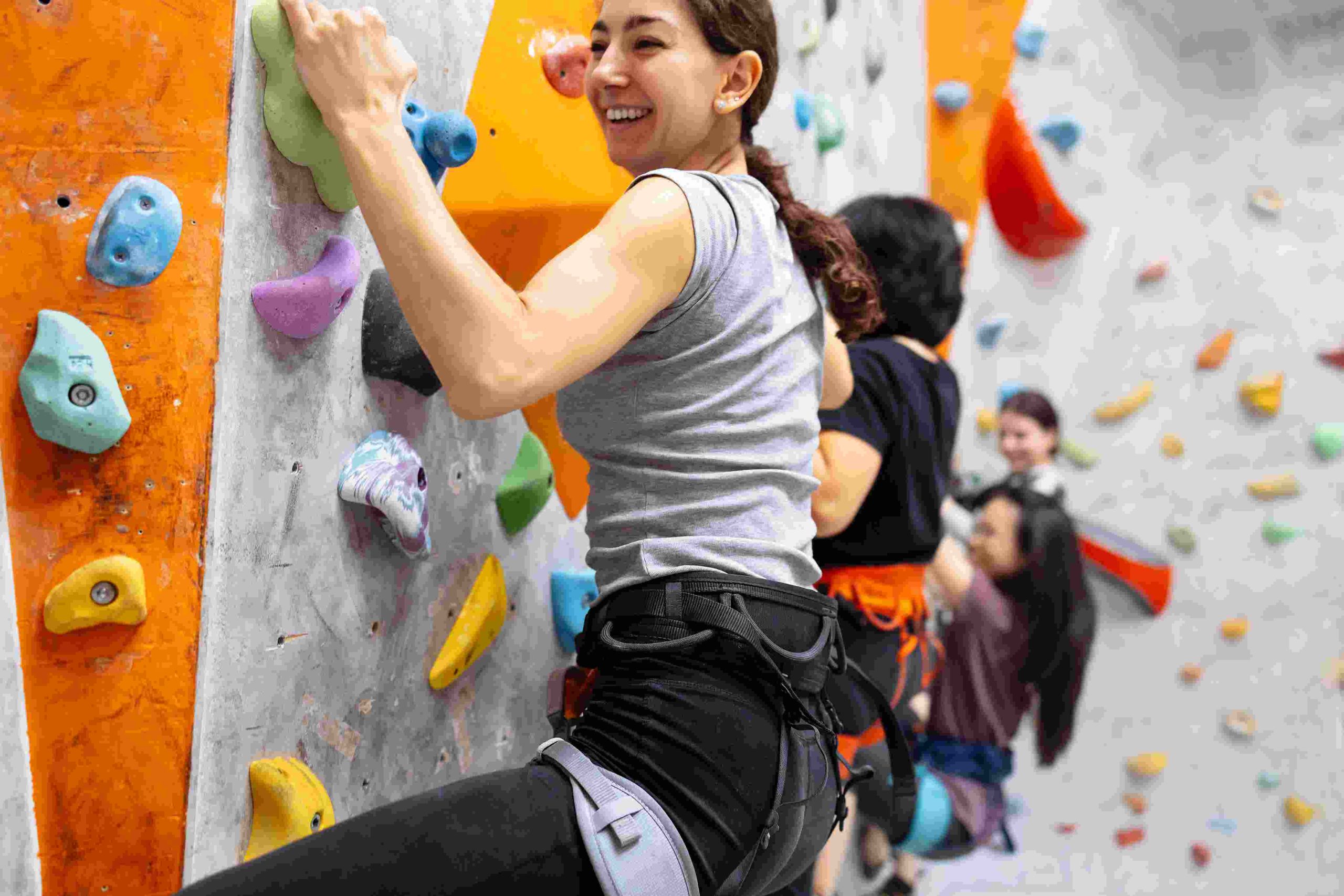Indoor rock climbing has surged in popularity, transforming from a niche activity to a mainstream fitness and recreational pursuit. According to the Climbing Business Journal, the number of commercial climbing gyms in the United States alone has a significant growth of 76% from 353 to 622 in the last decade according to INDY Weekly. This growth reflects the activity’s unique blend of physical challenge, mental engagement, and social connection. Whether you’re a seasoned athlete or a complete beginner, indoor rock climbing offers a dynamic and rewarding experience. This guide will take you through everything you need to know to get started and excel in this exciting sport.
The Amazing Benefits of Indoor Rock Climbing
Physical Fitness:
Indoor climbing provides a full-body workout. It engages muscles you didn’t even know you had, particularly in your forearms, core, and legs. Studies show that regular climbing can significantly improve grip strength, with climbers often reporting a noticeable increase within just a few weeks. The dynamic movements required for climbing also enhance cardiovascular health, burning calories and improving endurance. Furthermore, the constant stretching and reaching involved in climbing boost flexibility and coordination, reducing the risk of injuries in daily activities.
Mental Well-being:
Climbing is as much a mental challenge as it is a physical one. Each route presents a unique puzzle, requiring strategic thinking and problem-solving. This mental engagement can help reduce stress and improve focus, offering a form of active meditation. The sense of accomplishment after conquering a challenging climb also boosts confidence and self-esteem. Overcoming fear and pushing personal limits are integral parts of the climbing experience, fostering a sense of resilience.
Social Connection:
Climbing gyms are vibrant communities where people of all skill levels come together. Whether you’re belaying a partner or sharing beta (climbing tips), you’ll find opportunities to connect with others. Many gyms offer group classes and events, making it easy to meet new people and build lasting friendships. For individuals struggling with finding a social outlet, the climbing gym can provide a welcoming and supportive environment.
Your First Steps: Finding a Gym and Essential Gear
Choosing the Right Climbing Gym:
When selecting a climbing gym, consider factors like location, cleanliness, and the variety of routes. A good gym will offer routes for all skill levels, from beginner-friendly walls to challenging overhangs. Check if the gym has a welcoming atmosphere and a strong sense of community. Look for gyms with knowledgeable staff who can provide guidance and answer your questions. Many gyms offer introductory classes, which are perfect for beginners.
What to Expect on Your First Visit:
On your first visit, you’ll typically start with an orientation and safety briefing. Staff will explain the basic rules and demonstrate essential techniques. You’ll learn about different types of climbing, such as bouldering (short climbs without ropes), top-roping (climbs with ropes secured from above), and lead climbing (climbing while clipping into bolts). Understanding basic terminology like “holds,” “routes,” and “grades” is crucial for effective communication and learning.
Essential Climbing Gear for Beginners:
The most essential piece of gear is a good pair of climbing shoes. Proper fit is crucial for comfort and performance. Shoes should be snug but not painful. Chalk is also essential for improving grip, especially as your hands sweat. Many gyms offer rental options for shoes and chalk, allowing you to try different gear before investing in your own.
Mastering the Basics: Techniques and Safety Tips
Fundamental Climbing Techniques:
Beginners often make the mistake of relying too heavily on their arms. Proper footwork is essential for efficient climbing. Use your legs to push yourself up the wall, rather than pulling with your arms. Keep your weight close to the wall to maintain balance. Learn different grip techniques for various types of holds, such as crimps, slopers, and jugs. Most importantly, learn how to fall safely. Practice falling onto the padded mats and learn to roll to absorb impact.
Prioritizing Safety in Indoor Climbing:
Safety is paramount in climbing. If you’re top-roping or lead climbing, ensure you understand belaying techniques and always double-check your knots and equipment. Follow gym rules and regulations, and communicate clearly with your climbing partner. Always warm up before climbing and cool down afterward to prevent injuries.
Climbing Etiquette:
Respect other climbers by not walking under them and waiting your turn. Avoid giving unsolicited advice and be mindful of the space around you. Climbing gyms are shared spaces, and maintaining a respectful and supportive environment is essential.
Taking Your Climbing to the Next Level
Understanding Climbing Grades:
Climbing grades help you track your progress and set goals. Bouldering routes are typically graded using the V-scale (V0 being the easiest), while top-roping and lead climbing routes use the Yosemite Decimal System (YDS). Familiarize yourself with these grading systems and use them to challenge yourself appropriately.
Training and Improvement Strategies:
Consistent practice is key to improvement. Set achievable goals and track your progress. Incorporate cross-training exercises, such as pull-ups, push-ups, and core workouts, to build strength. Practice technique drills and learn from experienced climbers. Many gyms offer coaching and training programs.
Indoor Climbing Competitions:
Indoor climbing competitions are a great way to test your skills and experience the thrill of competitive climbing. Competitions typically include bouldering, speed climbing, and lead climbing events. Check with your local gym for upcoming competitions and consider participating.
Joining the Climbing Community and Exploring Outdoor Options
Finding Climbing Partners and Community:
Climbing gyms are excellent places to meet climbing partners. Participate in gym events and join online climbing groups and forums. Building a strong climbing community can enhance your experience and provide support.
Transitioning to Outdoor Climbing:
If you’re interested in outdoor climbing, it’s essential to gain the necessary skills and knowledge. Outdoor climbing involves different challenges, such as natural rock formations and weather conditions. Consider taking outdoor climbing classes and learning from experienced climbers.
Everything You Need to Know: Costs, Clothing, and More
Climbing gym memberships and day passes vary in price, typically ranging from $50 to $100 per month for memberships and $15 to $30 for day passes. Wear comfortable, athletic clothing that allows for a full range of motion. Finding climbing partners is easy at the gym. Simply introduce yourself and ask if anyone needs a belayer or climbing partner. Gym rules vary, so always familiarize yourself with the specific rules of your gym.
Start Your Indoor Rock Climbing Adventure Today!
Indoor rock climbing offers a unique blend of physical and mental challenges, fostering a strong sense of community. Whether you’re looking for a new fitness routine or a fun social activity, indoor climbing has something to offer. Don’t be afraid to try it out. Visit your local climbing gym, take an introductory class, and start your climbing adventure today! Share your experiences and ask questions in the comments below.




